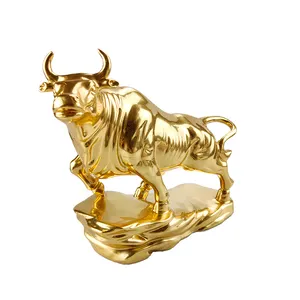

Factory OEM ODM Custom Famous Design Copper Cattle Statue Outdoor Large Metal Crafts Bronze Wall Street Bull Sculpture


Factory Customize Copper Goat Statue Products Home Metal Sculpture Golden Brass Bull Ornaments Brass Sculpture
























High-relief sculpture is a form of artistic expression wherein the depicted forms emerge prominently from a flat surface. This sculptural technique involves carving or modeling elements with considerable depth, creating a striking three-dimensional effect. The artist meticulously carves or molds the subject matter, ensuring it protrudes significantly from the background. The pronounced shadows cast by the elevated figures enhance the visual impact, emphasizing the sculptural details. High-relief sculptures often command attention with their intricate designs and detailed craftsmanship. Artists skillfully manipulate light and shadow to accentuate the contours, creating a captivating interplay of form and space. This method has been employed across various cultures and periods, serving as a testament to the enduring allure of this dynamic and visually engaging sculptural style.
Applications of high-relief sculpture are diverse, encompassing various artistic expressions. Bronze relief sculptures, known for their durability and intricate detailing, grace architectural facades, capturing historical narratives and cultural motifs with enduring elegance. These sculptural works, cast in bronze, often adorn public spaces, embodying a timeless aesthetic. Marble relief sculptures, prized for their luminous beauty and tactile quality, find applications in ornate interiors, depicting mythological scenes or symbolic representations. Both bronze and marble relief sculptures serve as captivating elements in commemorations, adding a dimension of visual richness to memorials and monuments. Their use extends beyond decorative purposes; these sculptures serve as tangible links to the past, narrating stories and embodying artistic mastery. Whether enhancing the grandeur of architectural structures or conveying narratives within confined spaces, high-relief sculptures in bronze and marble leave an indelible mark on the creative landscape.
High-relief sculpture, characterized by pronounced depth and sculptural elements projecting prominently from a flat surface, showcases distinctive features and materials. Crafted with precision, paper relief sculpture involves intricately cut and layered sheets of paper, skillfully manipulated to create dynamic textures and lifelike details. Similarly, cardboard relief sculpture utilizes cardboard's sturdy yet pliable nature, allowing artists to sculpt intricate designs with varying depths and dimensions. Both mediums offer a tactile and visually engaging experience, inviting viewers to explore the interplay of light and shadow on the raised surfaces. The meticulous craftsmanship of paper and cardboard relief sculptures creates captivating artworks that blend creativity with technical expertise, making them noteworthy additions to high-relief statues.
The art of high relief sculpture explores the intricate craft of bas-relief sculpture, a form of artistic expression where carved images emerge prominently from a flat surface. This captivating art form, characterized by its pronounced three-dimensional quality, entails meticulous carving to create depth and nuance. The artist skillfully manipulates the interplay of light and shadow, accentuating the details of the subject matter. Bas-relief sculpture has a rich historical tradition, with examples dating back to ancient civilizations. Masters of this craft employ various materials, such as marble, wood, or bronze, each offering unique challenges and opportunities. The viewer engages with the tactile qualities of the work, appreciating the artist's command over form and proportion. The art of high relief sculpture delves into this timeless technique, celebrating the exquisite precision and artistry of crafting visually compelling bas-relief sculptures.